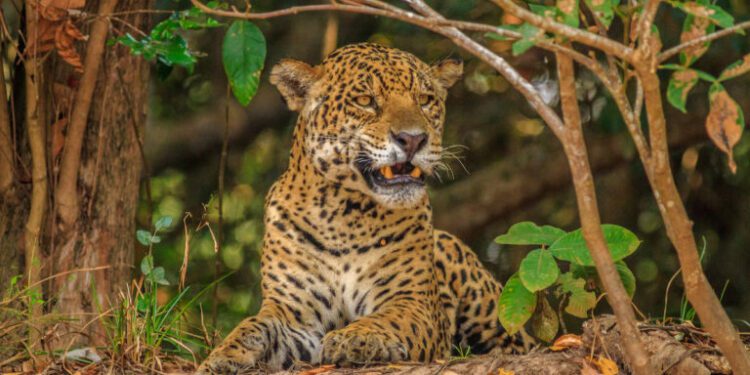ﻗThe recorder is very basic, designed to be reliable and without a lot of ﻗbells and whistles,ﻗﻗ Peter Wrege of the Cornell Lab of Ornithology, who helped design the Swift recording unit, told Mongabay in an email. ﻗI am now coming up on four years of continuous recording using 50 of these and the performance has been outstanding.ﻗ
Wrege also helped train the Panthera team to use the Swift units at a workshop he ran in Guatemala in 2017.
ﻗIt is fantastic to see this initiative paying off,ﻗ he said. ﻗAlways very rewarding to see former ﻗstudentsﻗ keep going and using the knowledge we helped them to gain.ﻗ
Castaﺣﺎeda says the Panthera team also uses SMART, a free spatial monitoring and reporting tool commonly used by conservationists and anti-poaching teams. This software helps them keep track of the dates, times and locations of each patrol, which they cross-reference with the data from the acoustical recordings.
ﻗThrough acoustics and SMART, we are monitoring our own success, and when looking at our data we can see that indeed, our patrol teams are deterring poaching,ﻗ Castaﺣﺎeda said.
The recording units, which are usually attached to trees, can pick up sound within a 1-kilometer (1,100-yard) radius, according to Panthera. Gunshots are one of the easiest sounds to detect. The recorders can also pick up conversations, and even animal noises.
ﻗWeﻗre starting to use our data to learn more about wildlife because weﻗre recording all the sounds of mammals and frogs and birds,ﻗ Castaﺣﺎeda said.
Panthera isnﻗt the only conservation group using acoustical recording to help combat illegal activities in protected areas. Rainforest Connection (RFCx), an NGO that works to prevent illegal logging in rainforests, also uses acoustics to track species and keep a check on illegal activities.
ﻗLarge-scale conservation requires an automated and inclusive remote sensing system for monitoring species occurrence in real-time,ﻗ Chrissy Durkin, director of international expansion at RFCX, told Mongabay in an emailed statement. ﻗAcoustic monitoring creates a game-changing capacity to expand the scope of biodiversity monitoring while simultaneously detecting threats.ﻗ
 Aereal view of Rﺣo Plﺣ۰tano Biosphere Reserve in Honduras. Image by Panthera.
Aereal view of Rﺣo Plﺣ۰tano Biosphere Reserve in Honduras. Image by Panthera.
While acoustical monitoring has changed the way that Panthera conducts its anti-poaching patrols, it hasnﻗt necessarily fixed the poaching problem, says Castaﺣﺎeda.
ﻗWe need to increase our patrols,ﻗ he said. ﻗWe already know patrols are effective. But we know poachers are going in the park when our patrol team is not out there. So we need more patrol teams. We need to hire more rangers to keep the park protected 24/7, 365 days a year.ﻗ
Escobar is in agreement about the need for more patrols. In fact, she and Castaﺣﺎeda are currently working on a funding proposal to hire and train more rangers to work in both Guatemala and Honduras, they said.
ﻗIt sounds pretty obvious that we need more rangers,ﻗ Escobar said. ﻗBut now we have evidence that supports that this work is actually working. Itﻗs having an important effect in the area. So thatﻗs a big thing.ﻗ
Editorﻗs note 02/26/2021: An earlier version of this article incorrectly stated that the jaguar corridor connected populations between Mexico and Brazil, but this was changed to state that the corridor runs between Mexico and Argentina. The headline was also amended.
Banner image caption: Jaguar in Brazil. Image by Dagget2 / Flickr (CC BY-NC-ND 2.0).
Elizabeth Claire Albertsﺡ is a staff writer for Mongabay. Follow her on Twitterﺡ @ECAlberts.
FEEDBACK:ﺡ Use this formﺡ to send a message to the author of this post. If you want to post a public comment, you can do that at the bottom of the page.
Acoustic, animal tracking, Animals, Big Cats, Bioacoustics, Bioacoustics and conservation, Carnivores, Conservation, Conservation Technology, Jaguars, Protected Areas, Technology, Technology And Conservation, Wildlife, Wildlife Conservation, Wildlife Corridors, Wildlife Crime, Wildlife Rangers, Wildlife Trade
Central America, Guatemala, Honduras
Source link : https://news.mongabay.com/2021/02/electronic-ears-spy-on-poachers-in-a-key-central-american-jaguar-habitat/
Author :
Publish date : 2021-02-23 03:00:00
Copyright for syndicated content belongs to the linked Source.












